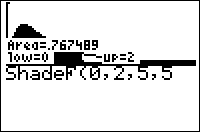TI-BASIC:Shadef
Command Summary
Finds the probability of an interval of the F-distribution, and graphs the distribution with the interval's area shaded.
Command Syntax
ShadeF(lower, upper, numerator df, denominator df)
Menu Location
Press:
- 2ND DISTR to access the distribution menu
- RIGHT to select the DRAW submenu
- 4 to select ShadeF(, or use arrows
TI-83/84/+/SE
2 bytes
ShadeF( is equivalent to Fcdf( in terms of the probability it calculates: if a random variable follows the F-distribution, you can use it to calculate the probability that the variable's value falls in a certain interval. However, in addition to calculating the probability, this command also draws the distribution, and shades the interval whose area represents the probability you want.
Note that this command does not actually return the value it calculates in Ans or anywhere else: it's merely displayed on the graph. If you're going to use the value in further calculations, you'll have to use Fcdf( as well.
Like Fcdf(, ShadeF( takes four arguments: the lower bound, the upper bound, and the numerator and denominator degrees of freedom.
Advanced
Often, you want to find a "tail probability" - a special case for which the interval has no lower or no upper bound. For example, "what is the probability x is greater than 2?". The TI-83+ has no special symbol for infinity, but you can use E99 to get a very large number that will work equally well in this case (E is the decimal exponent obtained by pressing [2nd] [EE]). Use E99 for positive infinity, and -E99 for negative infinity.
The ShadeF( command's output is affected by the graphing window, and on many windows you won't be able to get a good idea of what the graph looks like. The entire graph is in the first quadrant, so unless you want to see bits of the axes, Ymin and Xmin should be 0. Ymax should probably be around .5 - this would depend on the specific F-distribution of course, as would Xmax.
Keep in mind that ShadeF( is a drawing command and not the graph of an equation, so changing graph settings, the ClrDraw command, and a great deal of other things will erase its output.
